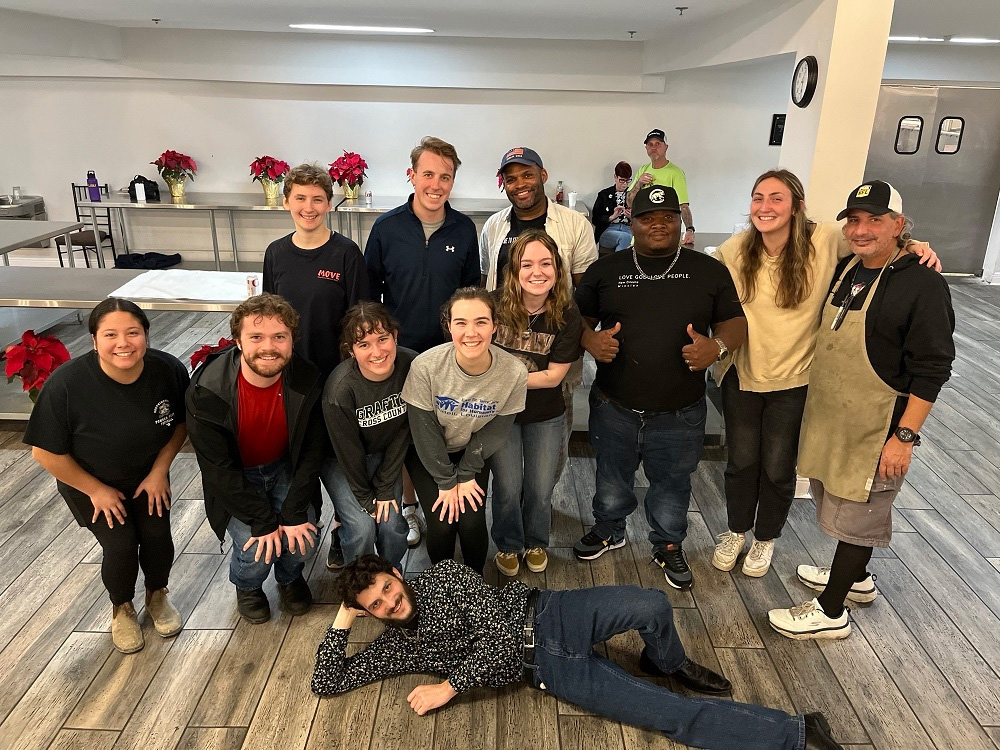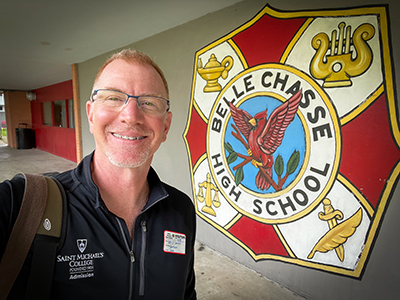A walk around The Waking
William Marquess, author of this essay from Saint Michael’s College Magazine’s Summer 2015 issue, is an instructor of English at Saint Michael’s. This essay is derived from the address he gave at Saint Michael’s to this year’s new members of Phi Beta Kappa at the induction ceremony on April 10, 2015
I have loved Theodore Roethke’s poem “The Waking” since I was first thrilled and baffled by it in college. When we take a walk around “The Waking”, that’s what we get: love, thrill, and bafflement.
The Waking
by Thedore Roethke
I wake to sleep, and take my waking slow.
I feel my fate in what I cannot fear.
I learn by going where I have to go.
We think by feeling. What is there to know?
I hear my being dance from ear to ear.
I wake to sleep, and take my waking slow.
Of those so close beside me, which are you?
God bless the Ground! I shall walk softly there,
And learn by going where I have to go.
Light takes the Tree; but who can tell us how?
The lowly worm climbs up a winding stair;
I wake to sleep, and take my waking slow.
Great Nature has another thing to do
To you and me; so take the lively air,
And, lovely, learn by going where to go.
This shaking keeps me steady. I should know.
What falls away is always. And is near.
I wake to sleep, and take my waking slow.
I learn by going where I have to go.
“The Waking” was published in 1953, at the height of Roethke’s career; he died ten years later. The poem is a villanelle, an old French form that depends on the repetition of two lines. In fact, if you’re writing a villanelle and you come up with two good lines, you’re practically there. But they’d better be really good lines, or the result will just be repetition. Ideally, the lines will take on greater resonance as they recur. We might think of it as a highly formal dance, in which these two partners step forward and back again and again, one of them sealing each tercet, until they’re united in the final quatrain.
From the start, the poem might baffle us with terms that seem contradictory: “I wake to sleep.” How can these things go together? Well, one response is that contradictions are part of our experience. Roethke admired the English poet William Blake, who declared that “without contraries is no progression.” This opening line announces that the poem may depend more on the tension of contraries than it does on traditional logic. But there’s also a little thrill in recognizing an experience we’ve all had, if we’ve ever hit the snooze alarm, to take our waking slow. This opening locates us in that extended moment of transition between dreaming and waking, so perhaps we shouldn’t expect the poem to deliver a simple clear message. And in fact I can’t offer a simple reading of the next line, except to say that alliteration calls attention to ideas the poem will explore: feeling, fate, and fear.
So already I’ve been baffled, and thrilled—and then comes the great third line, which I love, and which has become a kind of mantra for me: I learn by going where I have to go. This idea may be especially useful to young people who aren’t sure of their next steps. Of course you’d like to have a clear path, but sometimes you just have to have faith that you’ll find the path by walking. The great English writer Samuel Johnson says, “If a man wants to go north, he is more likely to get there by walking south than by standing still.”
The second tercet begins with a Romantic declaration: “We think by feeling.” Like many declarations, it’s an overstatement—but a bracing, memorable one. The second half of the line might be taken as a colloquial reinforcement of the idea—what is there to know?—but I’d say it’s also an earnest question: What is there to know? Then comes a line that I have taped up over my desk, to remind me of an ideal: “I hear my being dance from ear to ear.” When we are worthy of ourselves, being itself is a dance, and the music is underscored here by the chiming of the words “hear,” “ear,” “ear.” Of course, those final words usually describe a grin.
Now the poem makes a sudden turn toward something more personal. “Of those so close beside me, which are you?” Am I being addressed? Which am I, indeed? And then it turns again, offering no logical connection, challenging us even within the poem to learn by going: “God bless the ground!” Roethke grew up in Saginaw, Michigan, in a climate not unlike Vermont’s; his father and uncle managed a series of greenhouses, and also a neighboring wildlife preserve. As a boy Theodore was deeply attached to those plants and animals, and to the ground that sustained them. A modern hiker might well approve of his intention to walk softly there.
The natural scene deepens toward something mystical: “Light takes the tree, but who can tell us how?” It sounds like a rhetorical question, but the subsequent line seems to propose an answer: “The lowly worm climbs up a winding stair.” This is a moment that has always baffled me, and to some extent I have come to accept it as a mystery, the kind of mystery that makes any work of art—or any human being—more compelling. If the whole poem operated at this level,
I might lose patience—but it doesn’t. And I’ve also come to understand the line in a fairly straightforward way. Growing up among the greenhouses, Roethke had a great appreciation for the smallest elements of the natural world. His poems are full of worms, slugs, moles, roots, weeds, and stems; even the earth, in one of them, breathes a small breath. How does light take the tree? Ask the worm, and be ready to accommodate its slow response, rising, like light, imperceptibly.
From this small focus we move to the largest: “Great nature has another thing to do / To you and me.” Again I’m baffled: there’s no telling what this thing is, perhaps because all of us must discover it on our own. But I’m also exhilarated, as the speaker encourages me to “take the lively air,” and the refrain now omits the idea of compulsion: it’s not “where I have to go” but simply “learn by going where to go.”
And now everything slows, as the final quatrain is announced by two lines that are cut by periods that create heavy pauses. Even if we didn’t see the end of the poem ahead, we could feel it. And we return to the way of contradiction: how can it be that “this shaking keeps me steady”? Well, we are shaking: our hearts beat, our lungs flex, neurons fire across synapses; the earth spins, the planets wobble on their ecliptic, the galaxy drifts in space. We’re martyr to a motion not our own. And yet here we sit in the Recital Hall, listening to a guy talk. Somehow all that shaking keeps us steady. And there may also be a private reference here. Roethke was sometimes mentally shaky; he had manic episodes, and spent some time in a sanitarium. He may be smiling at himself: “I should know.” Such waltzing was not easy. But he also believed that a measure of shakiness might lead to a larger vision, something greater than the light of common day. “What falls away is always” might also seem baffling—but it’s really not. Perhaps those of us who are older know this best: the body decays, and mortality of some kind is always near. There are tears in things. But we can still dance. And so those two dancing partners, the refrain lines, return for a final bow, appearing for the first time back to back, dosey-do, cheek to cheek.
I’m pretty sure some of you will be familiar with a scene from “Game of Thrones,” season 1, in which Arya Stark, the young daughter of a noble family threatened by enemies, is receiving lessons in sword fighting, which she will soon need. It may seem odd, at first, that her teacher is a dancing master. But then, of course, it’s all in the footwork. And this teacher, Syrio Forel, offers metaphysical lessons as well as the physical moves. Even as unfriendly soldiers are approaching to kidnap Arya, he asks her a question she has clearly heard from him before: “What do we say to the god of death?” I’m going to pose that question to you now, and I hope someone will just call out the answer. What do we say to the god of death?
Not today. Not today. This is what art always says. It’s not a denial of death; in fact, the phrase implies that death will come, someday. Most things may never happen; this one will. But when we’re fully engaged in art—dancing, singing, painting, making a poem, reading a poem, hearing a poem—we’re alive, alive-o.





